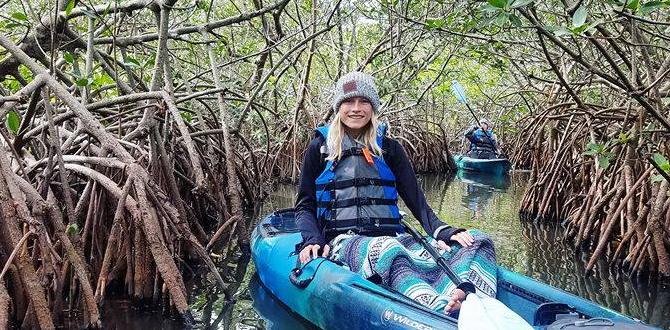The Blue Mountains best time to visit depends on what you’re looking for! For pleasant weather and fewer crowds, aim for spring (September to November) or autumn (March to May). These shoulder seasons offer mild temperatures ideal for exploring hiking trails and iconic lookouts. Keep reading for a detailed breakdown to plan your perfect trip!
Planning a trip to the breathtaking Blue Mountains can feel a bit overwhelming, especially when you’re wondering about the “perfect” time to go. Many travelers find it frustrating trying to balance incredible experiences with avoiding peak season crowds and navigating unpredictable weather. But don’t worry, we’re here to simplify it for you! This guide will walk you through the seasons, helping you pinpoint the ideal time for your visit to this UNESCO World Heritage area. Get ready to discover when to witness stunning vistas, enjoy comfortable hikes, and make the most of your Blue Mountains adventure!
Understanding Blue Mountains’ Seasons
The Blue Mountains, located just west of Sydney, Australia, boasts a diverse climate that changes significantly throughout the year. Understanding these seasonal shifts is key to planning a trip that aligns with your interests, whether you’re seeking vibrant autumnal colors, lush spring blooms, or cozy winter escapes.
Summer (December to February)
Summer in the Blue Mountains is generally warm to hot, with average temperatures ranging from the high teens to the mid-20s Celsius (60s to 80s Fahrenheit).
Pros:
Longer daylight hours are perfect for extended exploration and outdoor activities.
Waterfalls are often at their most powerful due to summer rains.
Lots of local events and festivals are typically held during this season.
Cons:
This is the peak tourist season, meaning popular attractions and walking trails can be very crowded.
Accommodation prices are usually at their highest.
Occasional heatwaves can make strenuous hiking uncomfortable or even unsafe. Bushfire risk also increases during hot, dry periods.
Autumn (March to May)
Autumn brings a spectacular display of colors as the deciduous trees change from green to shades of red, orange, and yellow. The weather is typically mild and settled. Temperatures range from the single digits to the low 20s Celsius (50s to 70s Fahrenheit).
Pros:
The scenery is absolutely stunning with the changing foliage, making it a photographer’s dream.
Fewer crowds compared to summer, offering a more relaxed experience.
Mild temperatures are excellent for hiking and exploring.
Prices for accommodation may start to decrease as the peak season winds down.
Cons:
Daylight hours begin to shorten, requiring earlier starts for full-day excursions.
Some facilities or attractions might reduce their operating hours towards the end of autumn.
Winter (June to August)
Winter in the Blue Mountains is cold, with temperatures often ranging from a few degrees Celsius to the mid-teens (30s to 50s Fahrenheit). Frost and occasional snow can occur, especially at higher elevations, transforming the landscape into a winter wonderland.
Pros:
The fewest number of tourists visit during winter, offering a truly serene and crowd-free experience.
Stunning, crisp air that can make vistas incredibly clear.
Beautiful frosty mornings and the possibility of snow create unique photographic opportunities.
Cozy cafes and log fires provide a warm retreat after a day of exploring.
Accommodation prices are generally at their lowest.
Cons:
It can be quite cold, requiring warm clothing layers for comfortable outdoor activities.
Shorter daylight hours mean less time for sightseeing.
Some walking trails might be slippery or inaccessible due to frost or ice.
Waterfalls might have reduced flow compared to wetter seasons.
Spring (September to November)
Spring sees the Blue Mountains burst into life with blooming wildflowers and lush greenery. The weather is usually pleasant, with temperatures similar to autumn, ranging from the high single digits to the low 20s Celsius (40s to 70s Fahrenheit).
Pros:
Beautiful blooming flowers and fresh green landscapes make for picturesque views.
Mild, comfortable weather is ideal for hiking and outdoor adventures.
Crowds are generally manageable, especially outside of school holidays.
The region comes alive with renewed energy after the winter months.
Cons:
Can still experience some unpredictable weather, including rain showers.
Accommodation prices may rise, especially around public holidays and school breaks.
While not as busy as summer, some popular spots can start to get crowded as the season progresses.
Blue Mountains Without Crowds: The Shoulder Seasons
For many travelers, the ultimate goal is to experience the magic of the Blue Mountains without the hustle and bustle of peak season. This is where the “shoulder seasons” truly shine.
Autumn: The Golden Opportunity
As mentioned, autumn (March to May) is a prime candidate for visiting the Blue Mountains without overwhelming crowds.
Why it’s great for avoiding crowds: School holidays are over, and the summer heat has dissipated. This makes it a sweet spot for visitors who prefer calmer environments.
What to expect: You’ll find pleasant temperatures perfect for walking and exploring national parks. The star attraction, of course, is the spectacular foliage. Think of fiery maples, golden oaks, and rich russets painting the valleys—it’s truly breathtaking.
Tips for crowd-free enjoyment: While generally less crowded than summer, weekends can still see local visitors. Consider visiting mid-week for the most serene experience. Book popular tours or accommodation in advance, especially for longer stays or if you have specific needs, like family-friendly options or accessible rooms. If you’re traveling with young children or need to manage personal care needs, like carrying discreet adult diapers for peace of mind during long sightseeing days, autumn’s calmer atmosphere can make this easier.
Spring: Nature Reawakens
Spring (September to November) offers another fantastic window for a less crowded, more immersive Blue Mountains experience.
Why it’s great for avoiding crowds: Similar to autumn, spring falls between major holiday periods. While there might be a slight uptick in visitors as the weather improves, it’s nowhere near summer levels.
What to expect: The landscape comes alive with vibrant colors from blooming wildflowers and fresh greenery. The air is crisp, and the temperatures are comfortable for a wide range of activities. It’s a beautiful time to see the waterfalls flowing well and the bushland rejuvenated.
Tips for crowd-free enjoyment: Again, mid-week visits are your best bet for ultimate tranquility. Many walking trails will feel more open. If your travel involves managing supplies for children, such as ensuring you have enough child diapers for a day out exploring, planning around these less busy periods makes packing and access much simpler. Enjoying hikes like the Prince Henry Cliff Walk or exploring the less-visited trails around Mount Victoria can offer stunning views with fewer people.
Best Time for Specific Activities
While shoulder seasons are ideal for crowd avoidance, the “best” time can also depend on what you want to do in the Blue Mountains.
Hiking and Bushwalking
The Blue Mountains National Park is a hiker’s paradise with hundreds of kilometers of trails.
Best times: Spring and Autumn offer the most comfortable temperatures for hiking, with averages between 15-25°C (59-77°F).
Summer: Can be too hot for strenuous walks. Always carry plenty of water, wear sun protection, and check the weather forecast. Early mornings are best.
Winter: Crisp and clear, but can be very cold. Trails may be icy. Essential to wear warm, waterproof layers and sturdy boots. Check trail conditions before heading out. For those who need extra confidence on longer trails, carrying personal care items like adult diapers can ensure comfort and freedom to explore without worry.
For official park alerts and trail conditions, always check the NSW National Parks and Wildlife Service website.
Photography
The Blue Mountains offer incredible photographic opportunities year-round.
Autumn: Renowned for its vibrant fall foliage, providing stunning landscapes and striking colors.
Spring: Captures the beauty of blooming native flowers and the fresh, green rebirth of the bush.
Winter: Offers dramatic, crisp light, misty mornings, and the rare beauty of frost or snow.
Summer: Lush greenery and often dramatic storm clouds can make for powerful shots. Waterfalls are typically at their most impressive.
Scenic Drives and Viewpoints
Iconic lookouts like Echo Point (for the Three Sisters), but also more secluded spots, are accessible year-round.
Best times: Early mornings and late afternoons offer the best light for photography and often fewer people at popular overlooks.
Weather considerations: Fog can sometimes obscure views in cooler months, but can also create a mystical atmosphere. Clear days are best for far-reaching panoramas.
Family Adventures
When traveling with children, comfort and ease are paramount.
Best times: Spring and Autumn offer the mildest weather for exploring attractions like the Scenic World railway or shorter, child-friendly walking tracks.
Summer: Can be fun but requires careful planning for sun protection and hydration. Longer days allow for more flexibility.
Winter: While cold, can offer unique experiences. However, shorter days and chillier conditions might be challenging for very young children. Planning for supplies, such as ensuring you have an adequate supply of child diapers and wipes, is crucial for stress-free outings. Packing these items in a separate bag or strategically in your daypack makes them easily accessible.
Planning Your Visit: A Seasonal Comparison Table
To help you visualize the differences, here’s a quick comparison of what to expect across the seasons.
| Feature | Summer (Dec-Feb) | Autumn (Mar-May) | Winter (Jun-Aug) | Spring (Sep-Nov) |
| :—————- | :——————————————— | :———————————————- | :——————————————— | :——————————————— |
| Weather | Warm to Hot, potential heatwaves | Mild & Pleasant, crisp air | Cold, frost, potential snow | Mild & Pleasant, some rain possible |
| Temperatures | 15-25°C (59-77°F) | 10-22°C (50-72°F) | 3-14°C (37-57°F) | 10-22°C (50-72°F) |
| Crowds | Peak Season, very crowded | Moderate, fewer than summer | Lowest Season, very few crowds | Moderate, fewer than summer |
| Scenery | Lush green, powerful waterfalls | Stunning fall foliage, golden hues | Crisp air, misty mornings, frosty landscapes | Blooming wildflowers, fresh greenery |
| Daylight Hours| Longest | Decreasing | Shortest | Increasing |
| Prices | Highest | Moderate | Lowest | Moderate |
| Ideal For | Waterfalls, longer days, summer events | Foliage, comfortable hiking, photography | Serene escapes, budget travel, snow spotting | Wildflowers, comfortable outdoor activities |
| Considerations| Heat, bushfire risk, booking essential | Shorter days later in season | Cold weather gear, slippery trails | Unpredictable rain showers |
Understanding Bushfire Risk
Given the Blue Mountains’ natural environment, bushfire safety is a crucial consideration, especially during warmer months.
When to be aware: Bushfire season typically runs from late spring through summer and into early autumn (October to March).
What to do: Always check the Rural Fire Service (RFS) website for the fire danger rating and any fire bans before and during your visit. Familiarize yourself with evacuation routes and stay informed via local news or emergency services. For the latest information, you can consult NSW RFS bush fire danger ratings.
Tips for a Comfortable Trip, Whatever the Season
Regardless of when you choose to visit, a few essential tips can enhance your experience and ensure comfort and preparedness.
Packing Essentials
Layered clothing: This is key for the Blue Mountains, as temperatures can fluctuate. Include base layers, fleeces, and a waterproof, windproof outer jacket.
Comfortable walking shoes: Essential for exploring any of the numerous walking tracks.
Sun protection: Hat, sunglasses, and sunscreen, even on cooler cloudy days.
Water bottle: Staying hydrated is crucial, especially when hiking.
Backpack: A daypack is perfect for carrying essentials. If you’re managing personal care needs, a discreet, well-designed backpack can easily accommodate items like adult diapers or child diapers, ensuring you have what you need without drawing undue attention. Look for bags with multiple compartments for easy organization.
Camera: To capture the stunning scenery!
Snacks: Especially if you plan on longer hikes or driving between towns.
Accommodation and Booking
Book in advance: This is highly recommended, especially if you’re traveling during school holidays, long weekends, or the peak summer and autumn foliage seasons.
Location matters: Decide if you want to stay in one of the main towns like Katoomba or Leura, or opt for a more secluded cottage or guesthouse.
Transportation
Car: Having a car offers the most flexibility to explore different lookouts and trailheads at your own pace.
Train: You can take a train from Sydney to the Blue Mountains, which is a scenic journey. Once in the mountains, local buses and taxis are available, but their schedules can be limited, especially for reaching more remote areas.
Tours: Guided tours from Sydney or within the mountains are a convenient option if you prefer not to drive.
Frequently Asked Questions About Visiting the Blue Mountains
Here are some common questions beginner travelers often ask:
Q1: Is it possible to visit the Blue Mountains without a car?
A1: Yes, it is possible! You can take a train from Sydney to the main towns like Katoomba and Leura. From there, local buses, taxis, and organized tours can help you get around to key attractions. However, having a car offers the most flexibility.
Q2: What are the absolute must-see attractions in the Blue Mountains?
A2: The iconic Three Sisters at Echo Point is a must-see. Scenic World in Katoomba offers a fun experience with its scenic railway, skyway, and walkway. Many visitors also enjoy exploring the charming villages of Leura and Blackheath, and hiking to less crowded waterfalls like Wentworth Falls or Katoomba Falls.
Q3: How many days do I need to see the Blue Mountains?
A3: You can get a good taste of the Blue Mountains in a single day trip from Sydney, focusing on the most famous sights. However, to truly relax, explore hiking trails, and visit multiple towns, at least 2-3 days is recommended for a more in-depth experience.
Q4: What should I pack for a day trip to the Blue Mountains?
A4: For a day trip, pack comfortable walking shoes, a jacket (even in summer, it can get cooler at altitude), sunscreen, a hat, a water bottle, snacks. If you have children, don’t forget child diapers, wipes, and any necessary medications or comfort items. A small backpack is ideal for carrying these essentials.
Q5: Are there child-friendly activities in the Blue Mountains?
A5: Absolutely! Scenic World is very popular with families. Shorter, easier walking trails like the Prince Henry Cliff Walk (in sections) or the trails around the Jenolan Caves (though further afield) are also enjoyable. Many cafes and picnic spots are family-welcoming.
Q6: What is the weather like in the Blue Mountains in (e.g., May)?
A6: May falls within the autumn season. You can expect cool and crisp weather, with average daytime temperatures often ranging from 10-18°C (50-64°F). Mornings and evenings can be quite chilly. The most significant draw in May is the beautiful autumn foliage, with trees turning shades of red, orange, and yellow.
Q7: I have incontinence issues and need to use adult diapers. Is it easy to manage this during a trip?
A7: Yes, it’s very manageable! The Blue Mountains are a popular destination, and most public restrooms are available. Carrying a discreet backpack stocked with adult diapers, wipes, and disposal bags allows you to feel secure and confident throughout your explorations. Planning your stops around toilet availability and choosing less crowded times can add extra peace of mind.
Conclusion
The Blue Mountains truly offer something special throughout the year, but for that sweet spot of pleasant weather, stunning scenery, and a more relaxed atmosphere, spring (September to November) and autumn (March to May) consistently emerge as the Blue Mountains best time to visit without crowds. These shoulder seasons allow you to fully immerse yourself in the natural beauty, tackle those inviting walking trails, and capture breathtaking photos without feeling rushed.
Whether you’re drawn by the vibrant hues of fall foliage or the fresh blooms of spring, planning your visit during these times ensures a more comfortable and personal experience. Remember to always check weather forecasts and




